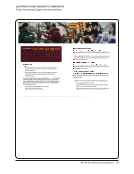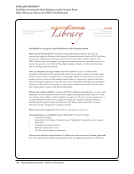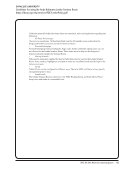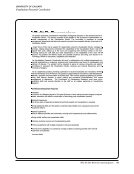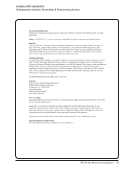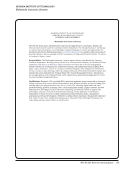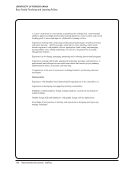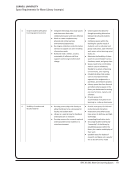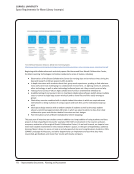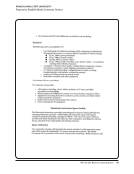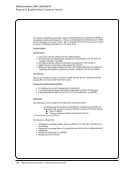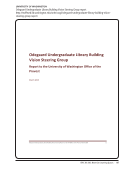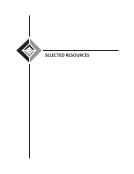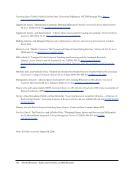14 · Survey Results: Executive Summary
go beyond the virtual and realize their ideas through
hands-on training, building, and tactile learning.
Finally, librarians are encouraging students to think
about the life cycle of their research, from the concep-
tion of an idea through collaboration or individual
study, to presentation and publication of original con-
tent. Libraries are also offering students the opportu-
nity to learn important presentation skills in order to
communicate their ideas to the academic community.
Programming
Next-Gen learning spaces are platforms for many
types of programming that can enhance learning,
inspire patrons, and create social or academic con-
nections. Programming and instruction overlap, in-
cluding events presenting coursework and library
classrooms hosting events. The Next-Gen learning
space can accommodate many modes of scholarly
communication and instruction while also creating
an open, social atmosphere.
Almost all of the libraries responding to the survey
indicated they held lectures (97%) and exhibits (93%)
in their spaces, along with presentations of student
work (89%), workshops (89%), social and networking
events (87%), and author talks (85%). Every type of
learning space identified in this survey was a pro-
gramming space in at least one responding library,
including quiet study space (28 of 69 responses) and
classrooms with fixed computers (49 of 68 responses).
Of the 70 libraries that identified who develops
or provides programming, 69 rely on librarians, 62
involve other library staff, and 56 rely on archivists.
Only 21 libraries have a full-time position dedicated
to programming. Libraries also host programming
provided by campus partners (48), other academic
institutions (31), and external partners (23).
Collaboration
One of the primary characteristics of Next-Gen learn-
ing spaces that distinguish them from information
commons is collaboration with partners outside the
library, who provide staff, technology, programming,
new services, designs for shared spaces, media re-
sources, and even funding. All but 10 of 70 responding
libraries have created or modified their spaces in col-
laboration with campus/parent institution partners or
external partners. Writing centers, information tech-
nology departments, learning and teaching develop-
ment departments, colleges and schools, and admin-
istrative support (such as the Office of the Provost)
were most prevalent in these collaborations. Of the
responding libraries, 50 collaborated with partners
from outside the library on instructional activities,
especially tutoring and writing instruction, and 44
collaborated with partners outside the library on pro-
gramming. External partners include research and
development companies, professional organizations,
non-profits, academic institutes, and state govern-
ments. The myriad educational uses of the spaces are
complemented by social, legal, and health outreach
(e.g., therapy dogs or a polling location).
Assessment
Most of the responding libraries (59, or 84%) are as-
sessing the success and effectiveness of their learn-
ing spaces through both qualitative and quantitative
methods. Informal feedback is the most common
assessment method for instructional activities and
programming (42), and for assessing the overall pur-
pose of the space (44). For instruction, surveys (40) are
almost as important as informal feedback. When con-
sidering overall success, libraries rely on gate counts
(42) and field observations (41) to supplement infor-
mal feedback.
In 24 of the responding libraries (36%), assessment
led to ending services, programs, or specific uses of
spaces, including removing reference desks, creat-
ing integrated service desks, and removing physi-
cal collections.
Sixty-two of the responding libraries (87%) have
used a Classroom Assessment Technique as part of
their instructional activities. The most commonly
used technique is feedback forms (60, or 97%).
Only 26 libraries (37%) are gathering metrics to
link library instruction or programming to student
success. Those metrics are varied and include engag-
ing outside partners for long-term assessment proj-
ects, consulting with faculty, and scoring rubrics. All
of the responding libraries collect data on the number
of classes and number of participants engaged in in-
structional activities. Assessing the Next-Gen learn-
ing spaces’ effects on student success and retention is
go beyond the virtual and realize their ideas through
hands-on training, building, and tactile learning.
Finally, librarians are encouraging students to think
about the life cycle of their research, from the concep-
tion of an idea through collaboration or individual
study, to presentation and publication of original con-
tent. Libraries are also offering students the opportu-
nity to learn important presentation skills in order to
communicate their ideas to the academic community.
Programming
Next-Gen learning spaces are platforms for many
types of programming that can enhance learning,
inspire patrons, and create social or academic con-
nections. Programming and instruction overlap, in-
cluding events presenting coursework and library
classrooms hosting events. The Next-Gen learning
space can accommodate many modes of scholarly
communication and instruction while also creating
an open, social atmosphere.
Almost all of the libraries responding to the survey
indicated they held lectures (97%) and exhibits (93%)
in their spaces, along with presentations of student
work (89%), workshops (89%), social and networking
events (87%), and author talks (85%). Every type of
learning space identified in this survey was a pro-
gramming space in at least one responding library,
including quiet study space (28 of 69 responses) and
classrooms with fixed computers (49 of 68 responses).
Of the 70 libraries that identified who develops
or provides programming, 69 rely on librarians, 62
involve other library staff, and 56 rely on archivists.
Only 21 libraries have a full-time position dedicated
to programming. Libraries also host programming
provided by campus partners (48), other academic
institutions (31), and external partners (23).
Collaboration
One of the primary characteristics of Next-Gen learn-
ing spaces that distinguish them from information
commons is collaboration with partners outside the
library, who provide staff, technology, programming,
new services, designs for shared spaces, media re-
sources, and even funding. All but 10 of 70 responding
libraries have created or modified their spaces in col-
laboration with campus/parent institution partners or
external partners. Writing centers, information tech-
nology departments, learning and teaching develop-
ment departments, colleges and schools, and admin-
istrative support (such as the Office of the Provost)
were most prevalent in these collaborations. Of the
responding libraries, 50 collaborated with partners
from outside the library on instructional activities,
especially tutoring and writing instruction, and 44
collaborated with partners outside the library on pro-
gramming. External partners include research and
development companies, professional organizations,
non-profits, academic institutes, and state govern-
ments. The myriad educational uses of the spaces are
complemented by social, legal, and health outreach
(e.g., therapy dogs or a polling location).
Assessment
Most of the responding libraries (59, or 84%) are as-
sessing the success and effectiveness of their learn-
ing spaces through both qualitative and quantitative
methods. Informal feedback is the most common
assessment method for instructional activities and
programming (42), and for assessing the overall pur-
pose of the space (44). For instruction, surveys (40) are
almost as important as informal feedback. When con-
sidering overall success, libraries rely on gate counts
(42) and field observations (41) to supplement infor-
mal feedback.
In 24 of the responding libraries (36%), assessment
led to ending services, programs, or specific uses of
spaces, including removing reference desks, creat-
ing integrated service desks, and removing physi-
cal collections.
Sixty-two of the responding libraries (87%) have
used a Classroom Assessment Technique as part of
their instructional activities. The most commonly
used technique is feedback forms (60, or 97%).
Only 26 libraries (37%) are gathering metrics to
link library instruction or programming to student
success. Those metrics are varied and include engag-
ing outside partners for long-term assessment proj-
ects, consulting with faculty, and scoring rubrics. All
of the responding libraries collect data on the number
of classes and number of participants engaged in in-
structional activities. Assessing the Next-Gen learn-
ing spaces’ effects on student success and retention is









































































































































